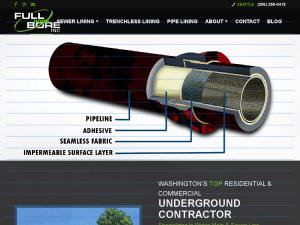Fullbore Sewer Lining Seattle
Fullbore Sewer Lining Seattle
1700 Westlake Ave N #200, Seattle, WA 98109
la mesa, CA 98109
1700 Westlake Ave N #200, Seattle, WA 98109
la mesa, CA 98109
Our Seattle sewer pipe lining process from start to finish
Many people are surprised to learn that cured in place pipe technology allows us to repair an existing sewer pipe without removing it from the ground. In the old days, we had to dig up and cut out the old problem section of pipe and replace it, but CIPP makes it possible to rehabilitate the old pipe and make it better than when it was new.
The new pipe lining is created by injecting epoxy resin into the old, damaged pipe. When it cures, the pipe becomes hard and smooth with a durable finish that can withstand just about anything. Pay close attention as we review each step of our Seattle sewer pipe lining process:
Video Diagnosis – At Full Bore, we believe in getting the most out of technology to make our lives easier and minimize the disruption to our customer’s lives. We use video to diagnose sewer pipe problems and pinpoint areas where defects are causing flow problems. We run a long scope through the pipe, fully assess the problem, and then offer you a solution based on our extensive experience.
Pipe Clearing – Before we can line the sewer pipe, we need to clear any obstructions. To accomplish this, we use a Pneumatic tool or high pressure water to clear out root and blockages, and scale off calcification. This is non-invasive and required no digging, as we simply work from one point of sewer pipe entry. Once the sewer pipe is fully cleared, it will be back to its original diameter. While there may still be cracks or gaps in the pipe, they will be fixed during the next phase of the CIPP process.
Pipe Liner Installation and Curing – Once the pipe is fully cleared we insert an epoxy lining and use a bladder to push the material into place. Once the sewer pipe lining is fully cured, we deflate the bladder before removing it entirely. What you’re left with is a perfectly smooth, durable, like-new sewer pipe.
Many people are surprised to learn that cured in place pipe technology allows us to repair an existing sewer pipe without removing it from the ground. In the old days, we had to dig up and cut out the old problem section of pipe and replace it, but CIPP makes it possible to rehabilitate the old pipe and make it better than when it was new.
The new pipe lining is created by injecting epoxy resin into the old, damaged pipe. When it cures, the pipe becomes hard and smooth with a durable finish that can withstand just about anything. Pay close attention as we review each step of our Seattle sewer pipe lining process:
Video Diagnosis – At Full Bore, we believe in getting the most out of technology to make our lives easier and minimize the disruption to our customer’s lives. We use video to diagnose sewer pipe problems and pinpoint areas where defects are causing flow problems. We run a long scope through the pipe, fully assess the problem, and then offer you a solution based on our extensive experience.
Pipe Clearing – Before we can line the sewer pipe, we need to clear any obstructions. To accomplish this, we use a Pneumatic tool or high pressure water to clear out root and blockages, and scale off calcification. This is non-invasive and required no digging, as we simply work from one point of sewer pipe entry. Once the sewer pipe is fully cleared, it will be back to its original diameter. While there may still be cracks or gaps in the pipe, they will be fixed during the next phase of the CIPP process.
Pipe Liner Installation and Curing – Once the pipe is fully cleared we insert an epoxy lining and use a bladder to push the material into place. Once the sewer pipe lining is fully cured, we deflate the bladder before removing it entirely. What you’re left with is a perfectly smooth, durable, like-new sewer pipe.
Customer Reviews for Fullbore Sewer Lining Seattle
Be the first to review Fullbore Sewer Lining Seattle - Use the thumbs to get started!
Fullbore Sewer Lining Seattle has not yet completed their interview.


